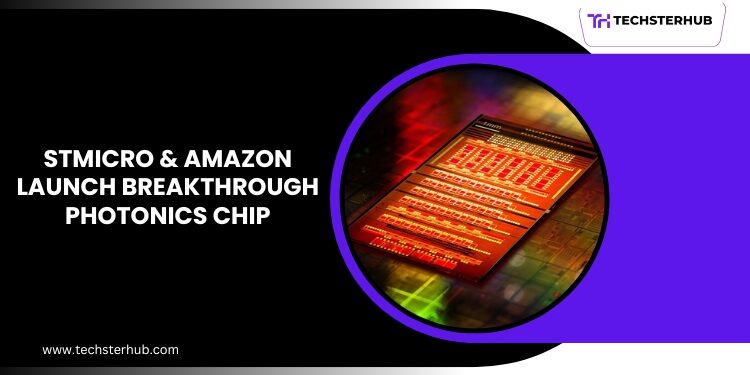STMicroelectronics has announced a new data centre photonics chip developed together with Amazon which marks a major advancement in semiconductor technology. Data centres which power cloud services and digital platforms will experience enhanced performance and efficiency thanks to this breakthrough technology. This chip will significantly enhance data transfer rates while decreasing power usage and accelerating cloud service operations. This article will explain the fundamentals of photonics chips and examine why the partnership between STMicroelectronics and Amazon matters, along with its potential impact on future data centre operations.
What Is a Photonics Chip?
We should explore what photonics chips represent and their significance before reviewing the development details by STMicroelectronics and Amazon.
Data centres have historically sent information through electrical signals transmitted along copper wires. Electrical data transfer has operated successfully for decades but it falls short in achieving high speed and maintaining energy efficiency. The science of light known as photonics provides the solution for these data transfer limits.
The function of photonics chips lies in their ability to use light particles (photons) rather than electrical signals (electrons) for data transmission. The ability of light to transmit data faster and more efficiently than electricity makes photonics an optimal option for high-speed data transmission over long distances. Photonics chips that use optical connections instead of electrical ones boost data centre performance by increasing speed and bandwidth while improving energy efficiency.
The move towards photonics technology in data centres represents a significant advancement because it enables rapid data processing while meeting the growing demands of cloud computing services. The technology enables swift development within artificial intelligence, machine learning, and big data analytics sectors.
What Is the STMicroelectronics-Amazon Partnership?
Amazon and STMicroelectronics have formed a partnership to create a state-of-the-art photonics chip that targets data centre applications. The partnership intends to produce a superior chip that will boost data transfer speed and energy efficiency in large-scale data centres that power Amazon Web Services (AWS) and various cloud platforms.
The collaboration between STMicroelectronics and Amazon combines two technology leaders who both possess significant technological knowledge. AWS’s parent company Amazon runs and manages expansive data centres across the globe. STMicroelectronics specializes in creating advanced semiconductor solutions which encompass photonics technology. Their collaborative efforts result in a chip that addresses numerous critical issues faced by today’s data centres.
This partnership’s photonics chip development will give Amazon and other cloud companies multiple advantages to boost their data centre operations.
Why Is This Photonics Chip Important for Data Centres?
The digital economy depends on data centres which serve as hosts for websites and social media platforms alongside cloud services and e-commerce operations. With data usage growing continuously data centres must now process larger information volumes at higher speeds without sacrificing efficiency. The new photonics chip plays a vital role in fulfilling these requirements because
- Faster Data Transmission: The photonics chip enables data transfer speeds that surpass those of traditional electrical signal methods. Light-based transmission enables data to move faster and experience fewer disruptions. Data centres become able to process bigger data sets more quickly due to the new photonics chip technology. The adoption of photonics chips may result in speedier cloud services along with faster web application response times while enhancing global user performance.
- Increased Bandwidth: Data centres need increased bandwidth capabilities to keep pace with the expanding demand for data storage and transfer. The photonics chip boosts bandwidth capabilities so data centres can handle larger data volumes without encountering performance bottlenecks. Industries such as artificial intelligence (AI) and big data need massive data transfers to operate effectively.
- Energy Efficiency: Data centres require substantial electricity to run their server infrastructure alongside cooling systems and networking hardware. Data centres can achieve significant energy consumption reductions by leveraging light-based data transmission through the photonics chip instead of traditional electrical methods. This approach serves a dual purpose by reducing operational expenses and promoting environmental sustainability. The primary purpose of this chip is to decrease energy consumption which benefits both business operations and environmental health.
- Scalability for Growing Demand: Cloud computing service demand grows exponentially as the digital world continues to expand. The rapid expansion of digital services requires data centres to scale their operations swiftly. The photonics chip manages growing data transmission needs through improved efficiency and scalable networking solutions. The implementation of this system allows data centres to expand their infrastructure capabilities without experiencing bottlenecks or delays.
- Reducing Latency: Latency represents the time delay experienced during data transfer between two points. Traditional data centres experience speed reductions in online applications because electrical signals create latency during data transmission. Photonics reduces latency substantially which allows for faster processing of data while enhancing the performance of cloud-based applications as well as streaming and other real-time services.
- Cost-Effective Infrastructure: The cost of maintaining and upgrading data centre infrastructure remains high due to the need to support increasing data transfer requirements. Data centres can benefit from reduced construction and operational costs by using photonics chips. Companies can optimize their existing infrastructure while preventing costly upgrades by enhancing data transmission speed and efficiency.
How Will This Impact Amazon and Its Customers?
This photonics chip plays an essential role in Amazon’s strategy to maintain its competitive advantage in the cloud services industry. As one of the world’s biggest cloud service providers Amazon must focus on enhancing its data center performance and efficiency. AWS’s introduction of this photonics chip will enable faster and more dependable cloud services for its customers.
For customers, the impact will be felt in several ways:
- Faster Cloud Services: The utilization of Amazon Web Services to host cloud services results in faster load times and quicker data processing while providing more reliable service for users. Businesses that use cloud platforms to run applications and store data need high-performance cloud services for essential operations.
- Improved Streaming and Content Delivery: The reduced latency and faster data transfer will improve Amazon Prime Video, Amazon Music and other streaming platforms resulting in superior experiences for their viewers and listeners.
- More Efficient AI and Machine Learning Models: The effectiveness of AI and machine learning models depends on quick data transfer of substantial data volumes. Through quicker data processing capabilities the photonics chip improves AI algorithm training and execution leading to faster and more accurate AI outcomes.
- Sustainability Benefits: The trend is growing where consumers seek companies who demonstrate sustainable practices. Amazon’s adoption of the energy-efficient photonics chip will enable a reduction in its carbon emissions which appeals to businesses and consumers who care about environmental sustainability.
What Does This Mean for the Future of Data Centres and Technology?
This photonics chip launch represents a single step within the broader transformation of data centre technology. The transition of numerous industries to cloud-based solutions will result in increased demand for high-performance data centres. Advancements in photonics technology will play a crucial role in satisfying the evolving demands for data centres.
The upcoming years will bring global data centres to adopt photonics widely. The implementation of photonics technology will provide significant advantages to major companies like Amazon and STMicroelectronics while simultaneously enabling advancements across various sectors including AI technology and autonomous vehicles. Photonics technology will drive the creation of faster computing systems which operate with greater efficiency and sustainability.
Conclusion
The joint development of a new data centre photonics chip by STMicroelectronics and Amazon represents a major development in computing and cloud services technology. This chip transforms data centre operations by enhancing data transfer speeds along with reducing energy consumption and boosting efficiency. Amazon will deliver accelerated cloud services with enhanced reliability and help achieve a more sustainable future through this development. Photonics chips developed by STMicroelectronics and Amazon will become essential to support modern technology as the cloud services market expands.











